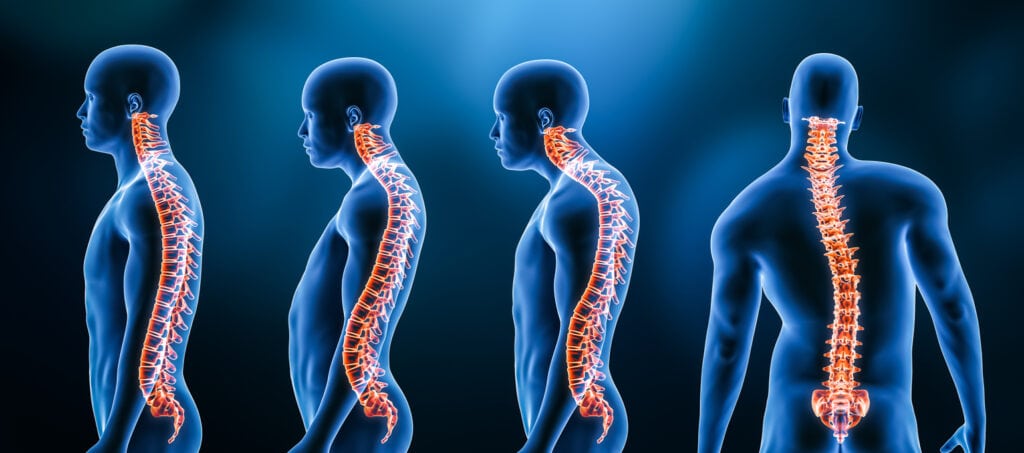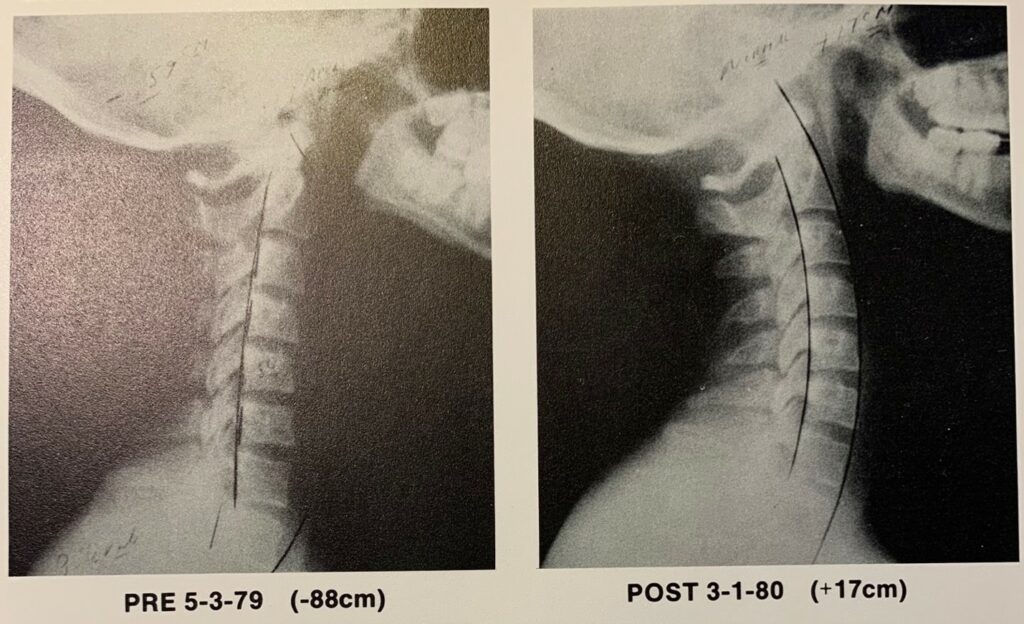The body is a structural wonder. The spinal column, bony yet flexible, encases the nervous system. Together, they provide coordination and support that allows all movement. In utero, the spine forms in a C-shaped configuration. As we grow and move into an upright posture, the spine develops into a balanced S-shaped posture, with the skull balanced perfectly above the base of the sacrum. Unfortunately, all sorts of habits and events throughout our daily lives threaten this balance: we fall on our butts, we fall on the back of our heads, we fall asleep in a chair with our chin on our chest, we spend hours peering down at books or mobile devices. Some of us have seen an elderly couple walking down the street, bent over and unable to even look up. So, what occurs in the spine, nervous system, and body when we can’t (or don’t) “Stand up straight!” like our mothers always told us?
In volume three of Kapandji’s textbook, Physiology of Joints, he states, “For every inch of Forward Head Posture (FHP), it can increase the weight of the head on the spine by an additional 10 pounds.” When cervical subluxations are present, they cause a loss of cervical lordosis. This creates an altered biomechanical posture shift, which in turn causes a forward head tilt to occur. With this imbalance occurring, the body will begin a process of continual protective bone remodeling to defend and strengthen vertebral bodies and discs. This is the Innate Intelligence response, meant to ultimately protect the spinal cord and nerve roots. This progressive and intelligently mediated depositing and absorption of bone tissue is a physiologically vital process to our survival. Guyton’s Textbook of Medical Physiology, 10th Edition describes bone remodeling in three phases:
Bone adjusts its strength in proportion to the degree of bone stress (subluxation or in fracture). Thus, bone thickens when subjected to heavy loads. Second, even the shape of the bone can be rearranged for proper support of mechanical forces (subluxation) by deposition and absorption of bone in accordance with stress patterns (altered bio-mechanics of movement from subluxation). Third, because old bone becomes brittle and weak, new organic matrix (real foods, vitamins and minerals) is needed as the old organic matrix degenerates.
These naturally intelligent and Innate boney changes were described in the nineteenth century and detailed in Wolff’s Law of bone remodeling. The creative design in the body reveals balance, order, and Innate control. What happens when the body is not in balance? Let’s stand up straight and start at the top.
The average adult head weighs approximately twelve pounds. When the head moves forward three inches from the center of gravity, or forward of the shoulders, the neck extensor muscles attempt to restrain against gravity a head equivalent to forty-two pounds. The misalignment of the neck in this posture creates a stress response through the entire spine and body and can directly affect the nervous system and general health. The body follows the head. Forward Head Posture (FHP) and the resulting loss of the natural cervical lordotic curve negatively affect functions throughout the body in many ways.
Let’s discover what’s hidden under our skin and revealed by an X-ray. Some effects FHP:*
- 30 percent loss of vital lung capacity
- Gastrointestinal system becomes sluggish in movement, absorption, and evacuation
- Increased aging of cervical disc, degeneration and arthritic joint destruction of bone, discs, and ligaments, and boney spur formation on the anterior margins of vertebra
- Disc destruction and resulting vertebral subluxation produces torque and tension upon the nerves exiting the spinal foramen, resulting in dysfunction of the tissues controlled by those nerves
- Dysregulation of all bodily functions from spinal pain, mood, blood pressure, pulse, muscle fatigue, sleep disruption, immune response, temperature regulation, physical balance, and the all-inclusive homeostatic functions of the body
- Loss of endorphins, which increases pain sensitivity decreases range of movement in the neck
Additionally, approximately 90 percent of the stimulation and nutrition directed into the brain is generated by the movement of the spine, and 90 percent of the energy output from the brain is spent on maintaining our upright posture. Only 10 percent of the brain’s energy output is directed to mental thought processes. Therefore, the strain of FHP robs our brains of vital rational thought energy.
Wow! All that from habits or injuries we may not give much thought: looking down all the time, whiplash, a history playing football and soccer, falling on the head, falling asleep in the highchair, sleeping on the back with an oversized pillow. The list goes on and on of ways the cervical spine can be knocked out of its ordained posture and balance. Chiropractic care with nutritional support corrects and defends against these imbalances.
These images show the before and after X-rays of the same patient over a span of approximately nine months of chiropractic care. The normal cervical lordotic curve was reestablished with the forward drop head piece following the protocols taught by Dr. Walter V. Pierce (DC, PhC, ScD). These same results were seen in hundreds of my patients in my 45 years of practice.

Our patients want results. They want to enjoy a life of greater health and wellbeing. They want to be able to hold their heads up high and walk in confidence and total health. We as chiropractors have the ability, knowledge, and skill to restore our patients’ spinal balance and prevent the detrimental effects listed above. Examine, identify, and correct. Is the spine in proper balance? Does it need nutritional support? Strengthen and stabilize the spine with the following nutritional support for disc and vertebra:
Avoid processed grain and sugar and replace these with healthy, natural protein and fats. And utilize chiropractic care to maintain healthy spinal balance.
“By failing to prepare, you are preparing to fail.”
—Benjamin Franklin
*Sources: J. Wickstrom and R. Rodiquez, Cervical Pain (New York: Pergamon Press, 1972).
Augustus A. White and Manohar M. Panjabi, Clinical Biomechanics of the Spine (Philadelphia: Lippencott, 1978).
Images from iStock/Moon Safari (main), libre de droit (post). X-ray image from Dr. Dority.


